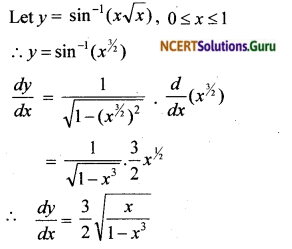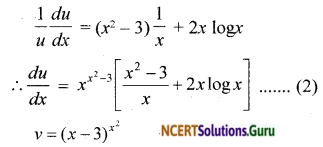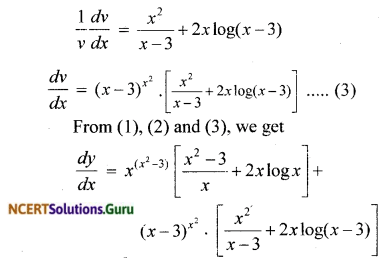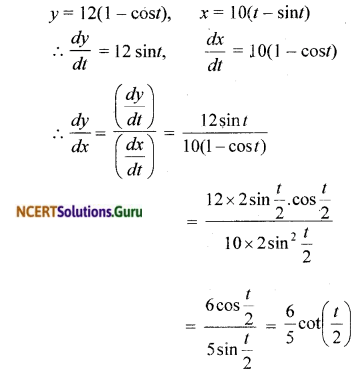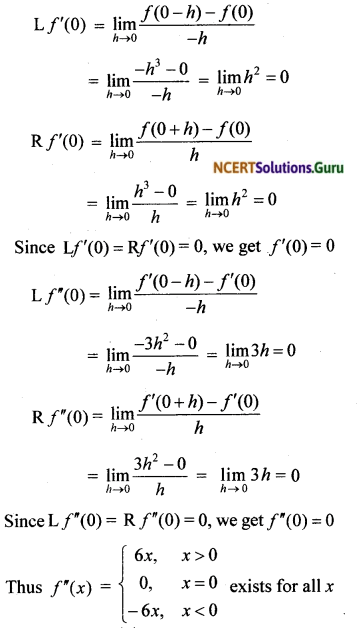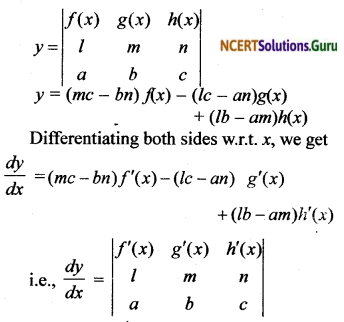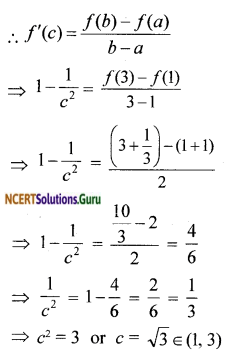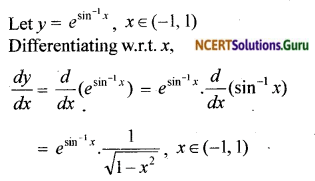NCERT Solutions for Class 12 Maths Chapter 5 Continuity and Differentiability Ex 5.8
These NCERT Solutions for Class 12 Maths Chapter 5 Continuity and Differentiability Ex 5.8 Questions and Answers are prepared by our highly skilled subject experts. https://mcq-questions.com/ncert-solutions-for-class-12-maths-chapter-5-ex-5-8/
NCERT Solutions for Class 12 Maths Chapter 5 Continuity and Differentiability Exercise 5.8
![]()
Ex 5.7 Class 12 Maths Ncert Solutions Question 1.
Verify Rolle’s theorem for the function
f(x) = x² + 2x – 8, x ∈ [- 4, 2]
Solution:
Now f(x) = x² + 2x – 8 is a polynomial
∴ It is continuous and derivable in its domain x ∈ R.
Hence it is continuous in the interval [- 4, 2] and derivable in the interval (- 4, 2)
f(-4) = (- 4)² + 2(- 4) – 8 = 16 – 8 – 8 = 0,
f(2) = 2² + 4 – 8 = 8 – 8 = 0
Conditions of Rolle’s theorem are satisfied.
f'(x) = 2x + 2
∴ f’ (c) = 2c + 2 = 0
or c = – 1, c = – 1 ∈ [- 4, 2]
Thus f’ (c) = 0 at c = – 1.
Ex 5.7 Class 12 NCERT Solutions Question 2.
Examine if Rolle’s theorem is applicable to any of the following functions. Can you say some thing about the converse of Rolle’s theorem from these example?
(i) f(x) = [x] for x ∈ [5, 9]
(ii) f (x) = [x] for x ∈ [-2, 2]
(iii) f (x) = x² – 1 for x ∈ [1, 2]
Solution:
(i) In the interval [5, 9], f (x) = [x] is neither continuous nor derivable at x = 6, 7, 8 Hence Rolle’s theorem is not applicable
(ii) f (x) = [x] is not continuous and derivable at – 1, 0, 1. Hence Rolle’s theorem is not applicable.
(iii) f(x) = (x² – 1), f(1) = 1 – 1 = 0,
f(2) = 22 – 1 = 3
f(a) ≠ f(b)
Though it is continous and derivable in the interval [1,2].
Rolle’s theorem is not applicable.
In case of converse if f (c) = 0, c ∈ [a, b] then conditions of rolle’s theorem are not true.
(i) f (x) = [x] is the greatest integer less than or equal to x.
∴ f(x) = 0, But fis neither continuous nor differentiable in the interval [5, 9].
(ii) Here also, theough f (x) = 0, but f is neither continuous nor differentiable in the interval [- 2, 2].
(iii) f (x) = x² – 1, f'(x) = 2x. Here f'(x) is not zero in the [1, 2], So f (2) ≠ f’ (2).
Question 3.
If f: [- 5, 5] → R is a differentiable function and if f (x) does not vanish anywhere then prove that f (- 5) ≠ f (5).
Solution:
For Rolle’s theorem
If (i) f is continuous in [a, b]
(ii) f is derivable in [a, b]
(iii) f (a) = f (b)
then f’ (c) = 0, c ∈ (a, b)
∴ f is continuous and derivable
i.e., f'(c) ≠ 0. Hence \(\frac{f(5)-f(-5)}{10}\)
but f (c) ≠ 0 ⇒ f(a) ≠ f(b)
⇒ f(-5) ≠ f(5)
Question 4.
Verify Mean Value Theorem, if
f (x) = x² – 4x – 3 in the interval [a, b], where a = 1 and b = 4.
Solution:
f (x) = x² – 4x – 3. It being a polynomial it is continuous in the interval [1, 4] and derivable in (1,4), So all the condition of mean value theorem hold.
then f’ (x) = 2x – 4,
f'(c) = 2c – 4
f(4) = 16 – 16 – 3 = – 3,
f(1) = 1 – 4 – 3 = – 6
∴ f'(c) = 0 \(\frac{f(b)-f(a)}{b-a}\) = \(\frac{f(4)-f(1)}{4-1}\)
⇒ 2c – 4 = \(\frac{-3-6}{4-1}\)
⇒ 2c – 4 = 1 ⇒ c = \(\frac{5}{2}\) ∈ (1, 4)
∴ Mean Value Theorem is verified for f(x) on (1, 4)
Question 5.
Verify Mean Value Theorem, if f (x) = x3 – 5x2 – 3x in the interval [a, b], where a = 1 and b = 3. Find all c ∈ (1, 3) for which f’ (c) = 0.
Solution:
f (x) = x3 – 5x2 – 3x
f'(x) = 3x² – 10x – 3
Since f'(x’) exists, f(x) is continous on [1, 3]
f(x) is differentiable on (1, 3)
f'(c) = 3c² – 10c – 3
f(b) = f(3) = – 27
f(a) = f(1) = – 7
∴ f'(c) = 0 \(\frac{f(b)-f(a)}{b-a}\)
⇒ 3c² – 10c – 3 = \(\frac{-27-7}{3-1}\)
⇒ 3c² – 10c – 3 = – 10
⇒ 3c² – 10c + 7 = 0
⇒ (c – 1)(3c – 7) = 0 ⇒ c = 1 or c = \(\frac{7}{3}\)
\(\frac{7}{3}\) ∈ (1, 3)
∴ Mean Value Theorem is verified for f(x) on (1, 3)
Question 6.
Examine the applicability of Mean Value theroem for all three functions given in the above Question 2.
Solution:
(i) F (x)= [x] for x ∈ [5, 9], f (x) = [x] in the interval [5, 9] is neither continuous, nor differentiable.
(ii) f (x) = [x], for x ∈ [-2, 2],
Again f (x) = [x] in the interval [-2, 2] is neither continous, nor differentiable.
(iii) f(x) = x² – 1 for x ∈ [1,2], It is a polynomial.
Therefore it is continuous in the interval [1,2] and differentiable in the interval (1,2)
f (x) = 2x, f(1) = 1 – 1 = 0 ,
f(2) = 4 – 1 = 3, f'(c) = 2c
∴ f'(c) = 0 \(\frac{f(b)-f(a)}{b-a}\)
2c = \(\frac{3-0}{2-1}\) = \(\frac{3}{1}\)
∴ c = \(\frac{3}{2}\) which belong to (1, 2)
NCERT Solutions for Class 12 Maths Chapter 5 Continuity and Differentiability Ex 5.8 Read More »









